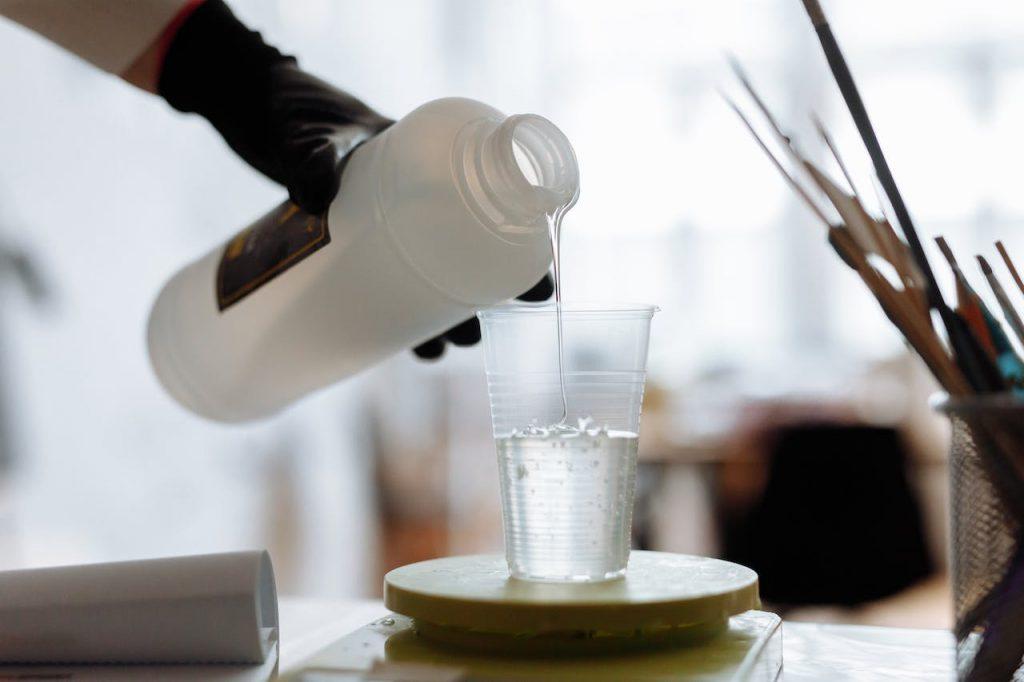The resin market has seen substantial growth in recent years, with the global epoxy resin market alone valued at approximately $8 billion in 2021 and expected to expand significantly by 2026. This surge is attributed to the widespread use of resins in industries like construction, automotive, and art.
Amidst this growth, a crucial concern has emerged: is resin toxic? This question is paramount for users ranging from professional artisans to hobbyists. Understanding the potential risks and adopting safe handling practices is essential. This article delves into the toxicity of different resins and offers practical tips for handling them safely.
What Is Resin?
Resin, in its broadest sense, is a viscous substance of plant or synthetic origin. It’s predominantly known for its plastic-like properties when cured, which has led to its extensive use in a variety of applications, from art and jewelry making to industrial manufacturing.
Natural resins, like amber or rosin, are derived from plant exudates and have been used historically for everything from varnishes to adhesives. These organic compounds are typically secreted by plants as a protective mechanism and are known for their sticky, semi-solid nature.
Synthetic resins, on the other hand, are man-made and have revolutionized numerous industries due to their versatility and durability. The most common types are epoxy, polyester, and polyurethane. Epoxy resin, for instance, is known for its strong adhesive properties and chemical resistance, making it ideal for coatings and laminates. Polyester resin is widely used in fiberglass and automotive body repairs, while polyurethane is favored for its flexibility and use in foams and varnishes.
The process of curing transforms resin from a liquid or semi-liquid state to a hardened, durable plastic. This is achieved through a chemical reaction, typically via the addition of a hardener or by exposure to ultraviolet light, depending on the type of resin. The cured product is noted for its clarity, high gloss, and resistance to moisture and chemicals, making it a popular choice for artisans and manufacturers alike.
Is Resin Toxic?
The question of whether resin is toxic is nuanced, as it largely depends on the type of resin and the stage of its usage. There are several types of resins commonly used in various industries and crafts, each with different chemical compositions and associated risks.
In their uncured state, many resins can be hazardous. They often contain volatile organic compounds (VOCs) and other chemicals that can be harmful if inhaled or come into contact with the skin.
The risks associated with resin largely diminish once it is fully cured. The curing process stabilizes the chemical compounds, significantly reducing the emission of harmful fumes. However, even in its cured form, the resin should be handled with care, particularly when sanding or cutting, as the dust created can be irritating to the lungs and skin.
Given these risks, it’s crucial to handle resins in a well-ventilated area and use appropriate personal protective equipment (PPE). This includes gloves, masks, and safety glasses. Additionally, it’s important to follow the manufacturer’s guidelines for mixing, curing, and disposing of resins.
Types of Resin
There are several types of resin commonly used, each with different chemical compositions and associated risks. Here are some of the most common types:
Epoxy Resin
Epoxy resin is a thermosetting polymer formed from the reaction of an epoxide “resin” with a polyamine “hardener”. Epoxy has excellent mechanical properties, high thermal and chemical resistance, and strong adhesion qualities.
It’s widely used in the production of strong, durable, and moisture-resistant products. Common applications include coatings for floors and metals, adhesives for various materials, and composites in the automotive and aerospace industries. In crafts, it’s popular for making jewelry, tabletops, and encapsulating objects.
Polyester Resin
This is a thermosetting resin, commonly unsaturated and used in combination with a liquid hardener. Polyester resin is known for its durability, water resistance, and ability to be easily shaped and molded.
It’s extensively used in the production of fiberglass (combined with glass fibers), boat hulls, car bodies, and roofing. In crafting, it’s used for making casts, sculptures, and jewelry.
Polyurethane Resin
Polyurethane resins can be thermosetting, thermoplastic, rigid, or flexible. They are characterized by their durability and excellent resistance to abrasion and solvents.
These resins find applications in foam products (like mattresses, car seats, and insulation), varnishes for wood, automotive parts, and the footwear industry for soles.
Silicone Resin
Silicone resin is a highly flexible, heat-resistant, and water-resistant material. It’s known for its excellent insulating properties and durability.
It is commonly used in cookware, medical devices, sealants, and coatings. In crafts, silicone resin is popular for mold making and casting due to its flexibility and non-stick qualities.
Alkyd Resin
Alkyd resins are polyester-based materials modified with oils or fatty acids. They form a hard, glossy, and durable film when cured.
They are primarily used in the production of paints and varnishes, providing a high-gloss finish to wooden surfaces, metals, and walls.
Phenolic Resin
Made from the reaction of phenol with formaldehyde, these resins are known for their high thermal stability, mechanical strength, and resistance to fire and chemicals.
Phenolic resins are commonly used in the production of circuit boards, billiard balls, and kitchen countertops and as adhesives in the construction of plywood and other wood products.
Acrylic Resin
These are thermoplastic resins formed by the polymerization of acrylic acid derivatives. They are known for their transparency, resistance to UV radiation, and weathering.
Acrylic resins are used in paints, coatings, adhesives, and sealants. They are also used in the production of plastic sheets (like Plexiglas), lenses, and dental materials.
Urea-Formaldehyde Resin
Formed by the chemical combination of urea and formaldehyde, these resins are known for their fast curing, hardness, and high tensile strength.
It’s widely used in the production of particle board, plywood, and other pressed wood products, as well as in adhesives and finishes.
Melamine Resin
Melamine resin is a hard, thermosetting plastic material made from melamine and formaldehyde. It’s known for its heat resistance and surface hardness.
This type of resin is commonly used in kitchenware, laminates, overlay materials, and in the production of whiteboards.
Vinyl Ester Resin
This is a thermoset resin produced by the esterification of an epoxy resin with an unsaturated monocarboxylic acid. Vinyl ester has high resistance to moisture and chemicals.
It’s often used in environments that require high corrosion resistance, like in pipes and tanks handling chemicals. It’s also used in the marine industry for building yachts and in the automotive industry for high-performance components.
Elastomeric Resin
These are flexible, rubber-like materials that can stretch and return to their original shape. They combine the toughness of metal with the elasticity of rubber.
Elastomeric resins are used in roofing materials, coatings, seals, and in applications requiring vibration damping.
Biodegradable Resin
As the name suggests, these resins are designed to break down over time. They are made from renewable bio-based resources.
Biodegradable resins are gaining popularity in packaging, agricultural films, and disposable items as a more environmentally friendly alternative to traditional plastics.
Safety Precautions When Working with Resin
Working with resin can be a rewarding creative or industrial endeavor, but it’s crucial to prioritize safety to protect your health and well-being. Here are comprehensive safety precautions when working with resin:
- Ventilation: Adequate ventilation is paramount when working with resin, especially epoxy and polyester resin, as they can release harmful fumes. Ensure your workspace has good airflow to dissipate any fumes.
- Personal Protective Equipment (PPE): Always wear appropriate PPE, including safety glasses, nitrile or latex gloves, and a lab coat or apron to protect your eyes, skin, and clothing from resin exposure.
- Respiratory Protection: In poorly ventilated areas or when handling large quantities of resin, wear a respirator with organic vapor cartridges to filter out harmful fumes.
- Skin Protection: Prevent direct skin contact by wearing long sleeves and long pants. In case of contact, wash the affected area immediately with soap and water.
- Eye Protection: Safety glasses or goggles should be worn at all times to shield your eyes from splashes or spills.
- Avoiding Food and Drinks: Do not eat, drink, or smoke in the work area to prevent accidental ingestion or contamination of food and beverages.
- Resin Compatibility: Ensure that the resin and hardener you are using are compatible. Mixing incompatible resins can lead to curing issues and compromised safety.
- Preparation: Read and follow the manufacturer’s instructions carefully for mixing ratios and curing times. Measure and mix resin and hardener accurately to ensure a proper chemical reaction.
- Temperature Control: Maintain the working environment at the recommended temperature range. Extreme temperatures can affect resin curing and quality.
- Clean Workspace: Keep your workspace clean and organized. Spills and drips should be cleaned up promptly to prevent accidents.
- Avoid Overexposure: Limit the time you spend working with resin to avoid overexposure to fumes. Take regular breaks in a well-ventilated area.
- Proper Disposal: Dispose of waste materials, such as used brushes, containers, and mixing tools, in accordance with local regulations for hazardous waste.
- Emergency Procedures: Know the location of safety equipment, such as eyewash stations and emergency showers, and have a plan for responding to accidents or spills.
- First Aid Kit: Keep a first aid kit on hand that includes materials for treating minor injuries like cuts and burns.
- Allergic Reactions: Be aware of potential allergic reactions to resin components. If you experience skin irritation or other symptoms, seek medical attention.
- Child and Pet Safety: Keep resin and related materials out of reach of children and pets. They may be curious and unaware of the dangers associated with these substances.
- Testing in Small Quantities: When trying a new technique or resin brand, start with a small quantity to minimize waste and assess compatibility.
- Storage: Store resin and hardener in a cool, dry place, away from direct sunlight and heat sources. Keep containers tightly closed to prevent contamination.
- Training: If you are new to working with resin, seek training or guidance from experienced individuals or resources to learn best practices.
Risks of Resin Exposure
Exposure to resin, especially in its uncured state, can pose various risks to health. It’s essential to be aware of these risks and take appropriate precautions to minimize them. Here are some of the primary risks associated with resin exposure:
Inhalation Risks
When working with certain types of resin, such as epoxy and polyester resin, inhaling the fumes or vapors can lead to respiratory issues. These fumes can cause irritation of the nose, throat, and lungs, leading to symptoms like coughing, wheezing, and shortness of breath.
Ensure adequate ventilation in your workspace, wear a respirator with organic vapor cartridges when necessary, and take regular breaks in well-ventilated areas to minimize inhalation exposure.
Skin Irritation
Direct skin contact with uncured resin can result in skin irritation, redness, and itching. Prolonged or repeated exposure may lead to contact dermatitis, characterized by dry, itchy, and inflamed skin.
Wear nitrile or latex gloves and long-sleeved clothing to protect your skin. If contact occurs, wash the affected area with soap and water immediately.
Eye Irritation
Splashes or accidental contact of resin with the eyes can cause irritation, redness, and discomfort. Eye exposure should be taken seriously as it can lead to more severe issues if not addressed promptly.
Always wear safety glasses or goggles when working with resin to protect your eyes. In case of eye exposure, rinse thoroughly with water and seek medical attention if irritation persists.
Allergic Reactions
Some individuals may develop allergic reactions to components of resin, such as epoxy or polyester. Allergic responses can manifest as skin rashes, hives, or respiratory symptoms like sneezing and congestion.
Be aware of any potential allergies to resin components. If you experience allergic symptoms, discontinue use and seek medical advice.
Toxic Chemical Exposure
Resin formulations may contain toxic chemicals or volatile organic compounds (VOCs) that can be harmful when inhaled or absorbed through the skin. Long-term exposure to these chemicals may lead to chronic health issues.
Use appropriate personal protective equipment (PPE), including gloves and a lab coat, to minimize skin contact. Maintain good ventilation and follow safety guidelines to reduce inhalation exposure.
Dust and Particulate Hazards
When sanding or cutting cured resin, it can generate dust and particulate matter that may irritate the respiratory system and skin.
Use a dust mask or respirator when sanding resin, and work in a well-ventilated area to reduce dust exposure. Wear appropriate PPE to protect your skin from contact with dust.
Ingestion Risks
Accidental ingestion of uncured resin can be toxic and lead to symptoms like nausea, vomiting, and abdominal pain.
Avoid eating, drinking, or smoking in the workspace. Store resin and related materials out of reach of children and pets.
Carcinogenicity
Some components in resin formulations, such as formaldehyde or styrene, have been classified as potentially carcinogenic by regulatory agencies. Prolonged exposure to these substances may increase the risk of cancer.
Follow safety guidelines to minimize exposure and wear appropriate PPE, especially when handling resins containing known carcinogens.
Are Resin Products Safe for Children and Pets?
Resin products, especially those that are fully cured, can generally be considered safe for children and pets when used as intended. However, it’s essential to understand and consider certain factors to ensure their safety:
- Cured Resin: Fully cured resin is less likely to pose health risks compared to uncured resin. Once the resin has undergone the curing process, which typically involves a chemical reaction and hardening, it becomes a solid and stable material that is less likely to release harmful fumes or cause skin irritation.
- Age-Appropriate Supervision: When involving children in resin crafts or projects, it’s crucial to provide age-appropriate supervision and guidance. Some resin-related activities may not be suitable for very young children due to the need for precision and safety precautions.
- Allergies and Sensitivities: Be aware of any allergies or sensitivities that children or pets may have to specific resin components. Some individuals may be more susceptible to skin irritation or allergic reactions, so it’s essential to monitor for any adverse reactions.
- Small Parts and Choking Hazards: In crafting with resin, small components or objects may be embedded in resin projects. Ensure that any small parts are securely encapsulated to prevent choking hazards for young children or pets.
- Ventilation: When working with uncured resin, especially epoxy or polyester resin, ensure that the workspace is well-ventilated to minimize exposure to fumes. Keep children and pets away from the work area until the resin has fully cured and the workspace is safe.
- Storage: Store uncured resin, hardeners, and related materials out of the reach of children and pets. These substances should be stored securely to prevent accidental ingestion or contact.
- Educational Opportunities: Involving children in age-appropriate resin projects can be educational and creative. It can teach them about art, science, and safety practices. However, always prioritize safety and provide clear instructions.
- Cleanup: After working with resin, ensure that all tools, containers, and surfaces are thoroughly cleaned to remove any residue. Resin spills or waste should be disposed of properly and securely to prevent access by children or pets.
- Pet Considerations: Pets may be curious about new smells and objects, so keep resin projects and materials away from their reach. Additionally, be cautious when using resin near pets to prevent any accidental contact.
Safe Disposal of Resin
The disposal of resin waste is a critical aspect of responsible craftsmanship and environmental stewardship. Whether you’re working with epoxy, polyester, or any other type of resin, it’s important to follow proper disposal methods to minimize environmental impact and ensure safety. Here are guidelines for the safe and responsible disposal of resin waste:
- Curing and Solidifying: Before disposal, allow any excess resin to fully cure and solidify. This process transforms the liquid resin into a solid, reducing its potential to leach into the environment.
- Scrap Collection: Collect cured resin scraps, drips, or trimmings and place them in a container designated for resin waste. Ensure that the container is compatible with the type of resin you’re disposing of.
- Local Regulations: Check your local regulations regarding the disposal of hazardous materials. Resin waste may be considered hazardous in some areas, and there may be specific guidelines to follow.
- Chemical Waste Facilities: Contact a local chemical waste facility or hazardous waste disposal service to inquire about their acceptance of resin waste. They may provide specific instructions for drop-off or pickup.
- Landfill Disposal: If there are no hazardous waste disposal options available, and resin waste is permitted in your local landfill, follow the guidelines for disposing of solidified resin waste. Ensure it is securely packaged to prevent leaks.
- Recycling: Some resin materials, such as certain types of epoxy, can be recycled. Check with recycling centers or facilities that accept plastics to see if they can process resin waste.
- Avoid Pouring Down Drains: Never pour uncured or liquid resin down drains or sewers. Resin can harden and cause blockages in plumbing systems, leading to costly repairs.
- Resin Waste Containers: Clearly label containers holding resin waste to indicate their contents. This helps prevent accidental misuse and ensures proper handling.
- Personal Protective Equipment (PPE): When handling resin waste, wear appropriate PPE, including gloves and safety glasses, to protect yourself from potential skin contact.
- Educate Yourself: Stay informed about the specific resin materials you’re using, as different types may have varying disposal requirements. Always refer to the manufacturer’s recommendations for disposal.
Resin is a versatile and exciting medium used in various crafts and projects. However, it’s essential to handle, use, and dispose of it responsibly to protect your health, the environment, and others around you. By following best practices for resin safety and disposal, you can continue creating beautiful and unique pieces while minimizing potential risks. So, keep learning about new techniques, materials, and safety measures to become a skilled and responsible resin artist. Happy creating.






